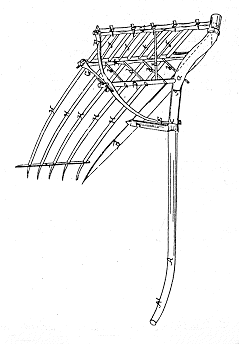Grain cradle on:
[Wikipedia]
[Google]
[Amazon]
 A grain cradle or ''cradle'', is a modification to a standard
A grain cradle or ''cradle'', is a modification to a standard

 As the cultivation of grain developed, the seasonal harvest became a major agricultural event. Grain could be pulled or, later, cut with a
As the cultivation of grain developed, the seasonal harvest became a major agricultural event. Grain could be pulled or, later, cut with a
 A grain cradle or ''cradle'', is a modification to a standard
A grain cradle or ''cradle'', is a modification to a standard scythe
A scythe ( ) is an agricultural hand tool for mowing grass or harvesting crops. It is historically used to cut down or reap edible grains, before the process of threshing. The scythe has been largely replaced by horse-drawn and then tractor mac ...
to keep the cut grain stems aligned. The cradle scythe has an additional arrangement of fingers attached to the snaith (snath or snathe) to catch the cut grain so that it can be cleanly laid down in a row with the grain heads aligned for collection and efficient threshing.
History

 As the cultivation of grain developed, the seasonal harvest became a major agricultural event. Grain could be pulled or, later, cut with a
As the cultivation of grain developed, the seasonal harvest became a major agricultural event. Grain could be pulled or, later, cut with a sickle
A sickle, bagging hook, reaping-hook or grasshook is a single-handed agricultural tool designed with variously curved blades and typically used for harvesting, or reaping, grain crops or cutting Succulent plant, succulent forage chiefly for feed ...
and tied into sheave
A sheave () or pulley wheel is a grooved wheel often used for holding a belt, wire rope, or rope and incorporated into a pulley
A pulley is a wheel on an axle or shaft that is designed to support movement and change of direction of a ...
s to be threshed. The scythe improved on the sickle by giving the mower a more ergonomic
Human factors and ergonomics (commonly referred to as human factors) is the application of psychological and physiological principles to the engineering and design of products, processes, and systems. Four primary goals of human factors learnin ...
stance and permitting a larger blade. However, keeping the grain stems aligned in the windrow
A windrow is a row of cut (mown) hay or small grain crop. It is allowed to dry before being baled, combined, or rolled. For hay, the windrow is often formed by a hay rake, which rakes hay that has been cut by a mowing machine or by scythe into ...
required great skill and where these skills were less available the addition of a cradle helped to manage the grain heads, reducing the sheaver's work-load and improving efficiency at threshing
Threshing, or thrashing, is the process of loosening the edible part of grain (or other crop) from the straw to which it is attached. It is the step in grain preparation after reaping. Threshing does not remove the bran from the grain.
History ...
. Lesser skilled mowers could harvest significantly more grain by using the cradle. Although the grain cradle was in previous use in parts of Europe it was not generally used because skilled labour was traditionally available. Between 1800 and 1840 the cradle was widely adopted in the expanding grain growing area of Midwestern United States
The Midwestern United States, also referred to as the Midwest or the American Midwest, is one of four census regions of the United States Census Bureau (also known as "Region 2"). It occupies the northern central part of the United States. I ...
, undergoing some refinement there and resulting in the American-pattern cradle. Fifty American patent
A patent is a type of intellectual property that gives its owner the legal right to exclude others from making, using, or selling an invention for a limited period of time in exchange for publishing an enabling disclosure of the invention."A ...
s were issued between 1823 and 1930, the first in 1823 in western New York state and the last in 1924 in West Virginia peaking between 1875 and 1900.
Hay does not require aligning and the scythe is more efficient without a cradle, so it was removed for haymaking.
Decline
The cradle was commonly used throughout the 1800s and into the beginning of the 20th century, in part because many of the smaller farms were not designed for mechanical reaping and in part because there were still a great number of smaller farms where the mechanical reaper was not economical. However, by the end of the 19th century the cradle had been generally replaced by the mechanicalreaper
A reaper is a farm implement or person that reaps (cuts and often also gathers) crops at harvest when they are ripe. Usually the crop involved is a cereal grass. The first documented reaping machines were Gallic reapers that were used in Roma ...
, a horse-drawn (or tractor-drawn) machine patented by Cyrus McCormick
Cyrus Hall McCormick (February 15, 1809 – May 13, 1884) was an American inventor and businessman who founded the McCormick Harvesting Machine Company, which later became part of the International Harvester Company in 1902. Originally from the ...
in 1834, and later by other mechanical methods of harvesting such as the combine harvester.
References
External links
{{Commons category-inline, Cradle scythes Cutting tools Mechanical hand tools Gardening tools